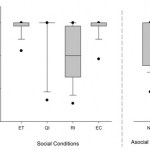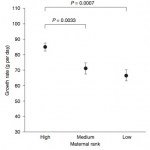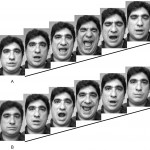nyt
This week is Social Media Week in Los Angeles, as well as in Mexico City, Milan, Bogota, and Buenos Aires.
What does that mean, exactly?
Social Media Week is a multi-city global conference connecting people, content and conversations around emerging trends in social and mobile media. Dozens of free events hosted at locations all over the city will bring together CEO's, entrepreneurs, journalists, bloggers, brand managers, CMO's, social media strategists, artists, activists and the technology/media digerati. Across a wide range of topics, industries and causes and with nearly 70 events…
Cooperation and conflict are both a part of human society. While a good deal of the academic literature addresses the evolutionary origins of conflict, in recent years there has been an increased focus on the investigation of the evolutionary origins of cooperative behavior. One component of cooperative behavior that might be present in other animals is aversion to inequity. Some scientists have suggested that inequity aversion may itself be the main factor driving the enforcement of cooperation. Put simply, inequity aversion is the resistance among partners to unequal rewards following…
Quandaries such as those involving stealing a drug to save a spouse's life or whether or not to have an abortion have historically dominated the study of the development of moral thinking. The predominant research programs in psychology today use dilemmas in which one choice is deontologically correct (it is wrong to rotate a lever that will divert a train and kill one person instead of five), and the other is consequentially correct (kill one person if it will save five others).
It is not surprising that psychologists have followed philosophers in proposing definitions for morality that…
At least one dog can be found in forty percent of US households, and forty percent of those owners allow their dogs to sleep on their beds. To put this in perspective, in a family with five children, two of them can be expected to become dog owners, and one of them will probably allow the dog to sleep on his or her bed. In an undergraduate lecture class of two hundred, eighty of those students come from homes with at least one pet dog. So as you might expect, dogs are a big business! In 2007, the pet industry was worth about $40 billion in the US, with dogs responsible for the largest share…
If I had to describe the mission, the point, the raison d'etre of the entire field of psychology in just one sentence, I would say: Psychology aims to determine the relative extents to which biology and experience determine cognition and behavior." And, as you might expect, there are widely differing schools of thought. Nativists emphasize genetics, biology, and innate mechanisms. By contrast, the empiricists insist that babies are born into the world with no a priori knowledge thereof, and just a powerful statistical associative learning mechanism by which they piece together their…
Figure 1: A mother hyena with her cubs.
Early developmental experiences can have significant implications for the growth, behavior, survival, and reproductive success of an individual. In many species, one of the most important factors that affects an individual's early development is the maternal environment. However, mothers not only provide an environment for their offspring, but also half of their genes, making it difficult to separate the effects of nature and nurture when investigating developmental outcomes in the offspring. Moreover, because male mammals usually disperse from the…
Predator-prey interactions are often viewed as evolutionary arms races; while predators improve their hunting behaviors and their ability to sneak up on their prey, the prey improve upon their abilities to detect and escape from their predators. The problem, of course, is that there is a trade-off between maintaining vigilance - the attention necessary to be consistently aware of others in the environment takes quite a bit of physical and mental energy - and doing all the other things that an animal must do, such as finding its own food. As a result of this trade-off, many social species,…
Earlier this week I wrote about the developmental and evolutionary origins of large number representation. A series of studies in human infants, monkeys, rats, and fish demonstrated that animals and humans spontaneously represent large (>4), abstract, approximate numerosities. Animals, human infants, and human adults, show the same ratio signatures (based on Weber's Law). Adult tamarins are on par with 9-month-old human infants. With age or training, discriminability becomes more precise, and the the critical ratio is reduced a bit. There is good evidence that the large number…
There's also a shortage of clean water. Friend of the blog Melissa Rowley is working to fix that.
She writes:
When I see photographs of children in developing countries, I ponder what my life would have been like had I not been adopted. My being here, here and now, and not roaming the streets of Korea or ending up as a sex trafficking tragedy, is more than a coincidence. It's a miracle. The longer I live the more certain I am that I was put on this planet to help those who need compassion, care, and a call to action to help them help themselves.
...the women who are mothers and nurturers…
If there is one book that every human should read, it is The Invisible Gorilla, by Chris Chabris and Dan Simons.
I suppose that's a pretty bold statement to make. Let me explain. As a student of psychology, and as someone who studies and writes about the mind, I am overwhelmed with the general perception among the lay public that "social science findings often reaffirm or echo what common sense observations tell us." But the truth is that common sense observations often lead us astray. We have very little insight into the way our minds actually operate. And the thing is, this is likely a…
It's been a pretty long stressful week around here, and not just because of Pepsipocalypse and the resulting fallout. But, well, I'm back, and I have an awesome paper to tell you about. When I saw it I just KNEW it had to be blogged.
Mythbuster Adam Savage sets the yawning in motion in Mythbusters attempts to start a yawning epidemic across the globe
Did watching that video make you yawn? Chances are it did, and you can thank contagious yawning for it. What is contagious yawning? Contagious yawning is a very well-dcoumented phonemenon wherein yawning is triggered by the perception of others…
Bonobo Week continues! I'm donating whatever proceeds I receive from my blogging shenanigans for the entire month of June to help the bonobos at Lola Ya Bonobo.
Imagine that you're wandering in the desert and you come across two magic lamps. One lamp grants three wishes. It's your standard sort of magic lamp with a genie in it. (No wishing for extra wishes, of course.) The second magic lamp is, well, a moody magic lamp. It's inconsistent. Sometimes it grants one wish, and sometimes it grants seven wishes. But the thing is, you don't know for sure whether, when you rub the lamp and genie pops…
The perspective that whales, dolphins, and other such marine mammals should be afforded "human rights" has surfaced again.
I thought I'd revisit a post I wrote about this several months ago, from the archives, when this first hit the news after the AAAS conference in San Diego. So here's a modified, updated version of the original post.
The blogosphere is all a-twitter with talk of the recent commentary in Science that dolphins should be considered people. Well, sort of people. Non-human people.
On the heels of the incident at SeaWorld in Florida in which a trainer was killed by one of the…
[Below is a longer, less edited version of an article I wrote for my department newsletter this month.]
Is science blogging something that belongs to Science or to Journalism? Clearly more and more scientists are communicating online. In a time when mainstream media are obliterating their science departments, science blogging is growing, and the few science journalists left are increasingly turning to science blogs for story ideas. And so is the general public. A recent press release from ScienceBlogs indicated that the network, the top social media network in the science category, had…
What is culture? One simple definition might be: a distinctive behavior shared by two or more individuals, which persists over time, and that ignorant individuals acquire through socially-aided learning.
There are at least four different ways to learn a particular behavior or problem-solving strategy. That is to say, there are four different ways to learn. The first is social facilitation, in which one individual does the same thing as the demonstrator at the same time. Essentially this is a situation of on-line matching of motor actions. For example, I might learn the steps to a complicated…
Let me tell you a little story. When I was born my parents had two cats. One was named Garfield. The other...well, I don't remember what the other one was called. Not long after I was born, and little Jason was coughing up furballs, the doctors informed the parents that their little bundle of skin and hair was allergic to cats. It was then that teams were picked and lines were drawn. It was me or the cats. Luckily, the parents decided to keep me, and lose the cats. Imagine how much it would have sucked if they decided to keep the cats and lose me. I imagine if my younger brother had actually…
Earlier this week we talked about how to use whale snot for science.
I especially enjoyed blog bff Scicurious's take on the study:
Budgetary requirement: $5000 for series of expensive remote control helicopters.
Source: Toys R Us.
Justification: Need something that can fly close to a whale and collect snot for measurement. Also, this is the only kind that comes in red, and the gunmetal grey ones suck.
This day, however, we will travel farther, er, south. Through the mouth, down the esophagus, into the stomach, detour through the intestines, take a left at the sphincter, but, what, what's…
Happy Earth Day, everyone!
In honor of the day, here's a modified re-post of piece I wrote recently for LAist.
Figure 1: Photo by poloroid-girl via LAist Featured Photos on Flickr.
The great philosopher Kermit the Frog once said, "It's not that easy being green." Maybe he was on to something.
You can't walk three steps down an aisle in any store without running into eco-friendly or "green" products. You probably have many of these products. Is your refrigerator or dishwasher Energy-star compliant? Do you have a paperless Kindle? Maybe bamboo guest towels in the bathroom? A Prius?
Why do you…
Figure 1: Humpback whale
The question is: what do you use to study the health of whales in the wild?
The answer is: not what you'd think.
Unlike smaller sea mammals like seals or sea lions, it is very hard to obtain blood samples from whales without first killing them.
Meet Karina Acevedo-Whitehouse, from the Zoological Society of London. She studies whale health, but has had to rely on dead, stranded or captive animals for blood samples, which are hardly representative of whales in the wild.
Figure 2: Dr. Karina Acevedo-Whitehouse
So what's the next best thing to whale blood? Well, SNOT,…
Do animals create art? So far, this seems a uniquely human ability.
But do animals have a sense of the aesthetically pleasing? What about the ability to judge and critique art? Can an animal decide if a given work of art is beautiful or ugly? What is beauty in the first place? All good questions.
Shigeru Watanabe of Keio University in Tokyo wanted to investigate the questions, with pigeons. Did he introduce them to the works of Picasso? Or Rembrandt? Romero Britto? No. He used art created by children.
Figure 1: Your kid's newest art critic.
Before we get into his experiment, lets take a…














